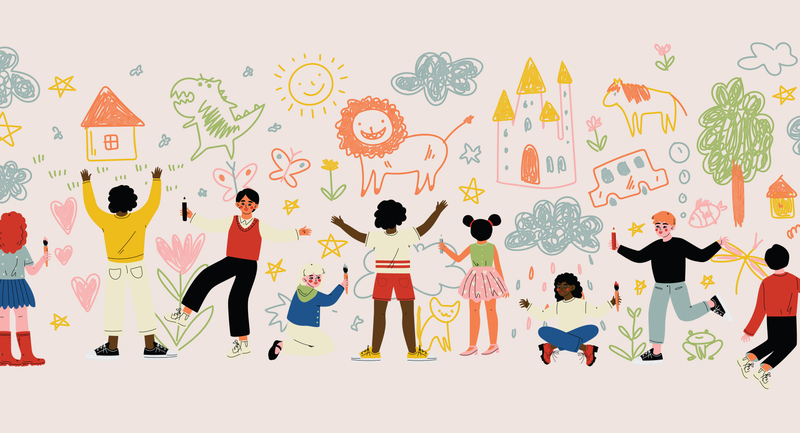All the 5th graders in my school take their yearlong "It" projects seriously. Rose wanted to study either photography or cooking. As she began to investigate these topics, she found a natural connection between the two: food styling, which involves arranging food to be professionally photographed. Rose contacted her mother's old college roommate, who worked for the magazine of chef Rachael Ray, to see whether she could visit the set. There, she had the opportunity to participate in a photo shoot; she also tested a recipe for the magazine and ended up appearing in its pages. She met briefly with Rachael Ray herself, who had heard about this young lady and her compelling school project. At the "It" fair we held at the end of the year, Rose demonstrated with multiple dishes how food stylists would prepare these foods for the camera.
Max knew immediately what he wanted to study for his "It" Project—locks and dams. As part of his research, he traveled to the lock and dam in Erie, Pennsylvania. In a conference I held with him midway through the year, Max impressed me with his ability to clearly explain this engineering marvel. Using the language of an engineer, he demonstrated his knowledge at the fair with a huge wood and Plexiglas model that simulated how locks and dams work.
Laura's project began with a simple question: If I know the coloration of both rat parents, can I predict the coloration of their offspring? Laura and her mother traveled to Ohio to purchase a male rat for breeding. As she awaited the birth of the babies, Laura learned everything she could about rat genetics. Once the babies were born, she was able to map their eye and fur color. Given her fairly advanced knowledge of genetics, she was able to explain the variability in outcome as the result of the delicate balance of dominant and recessive genes.
Fifth graders in my suburban school outside Pittsburg, Pennsylvania, are becoming experts on a wide variety of topics (See Students' Areas of Expertise). Here's how the program started.
Enthusiastic About Learning
Inspired ideas strike when you least expect them. During a drive home from graduate school, I was listening to an audiotape by pediatrician Mel Levine, cofounder of All Kinds of Minds, in which he spoke about ways to tailor instructional techniques to the way kids' brains actually work. What I found most compelling was a simple idea—that every child needs to be an expert on something. The seed of what would soon become my 5th grade research project had just been planted.
The power and benefits of this notion were quite profound. If I gave students the autonomy to select a topic they were passionate about, spend a full school year reading and learning everything they could about their topic, and complete their elementary career at 5th grade "graduation" with a fair to showcase their expertise for an audience, how might they grow as readers, thinkers, and believers in themselves?
Why did this notion of student expert speak to me so strongly? Just like many of my colleagues, I was increasingly frustrated by the apathy and disenfranchisement that many of my students felt. Learning was not a contact sport for large numbers of students; rather, they came to school as passive spectators.
How could I get my students passionate about learning? I knew that self-selection and student ownership were at the crux of developing student enthusiasm for the burgeoning project. I would teach students how to properly cite sources and how to select a note-taking method that suited their individual learning styles. Beyond that, they were captains of their own research universe. They could choose their topic and the means of demonstrating mastery. Although my students were not accustomed to being given carte blanche when it came to their learning, I guessed that they would enthusiastically seize the opportunity to take control, with support from a trusted adult.
Finding "It"
In 2005, eBay aired an advertising campaign telling people they could find their "it" on eBay—"it" being that special something that inspires, awes, charms, and challenges the individual. I struck on the perfect title for the project. The Osborne Elementary 5th Grade "It" Project would do just that—create a mechanism for inspiring and challenging students to pursue a personally significant topic in depth over an entire school year. This is how the program works.
Selecting a Topic
In September, I ask students to select a research topic they are passionate about. I added a crucial step at this point after the second year of the project to help level the playing field for many of my students. I realized that some of my students had the luxury of a broad base of life experiences—they traveled; they visited museums, art galleries, and historical sites; their homes were linguistically rich environments where they talked and read with adults. However, an equally large portion of my students had limited exposure to the world outside our small community. When asked to pick a topic, some students simply didn't know what they didn't know.
I needed to find a quick way to expose the 5th graders to a broad range of significant events, ideas, and people. I thought of Billy Joel's "We Didn't Start the Fire" music video, which includes a video montage of historically and culturally significant images. Something like this could help bridge the gap between the haves and the have-nots.
So I set out to create my own music video—one that would be appropriate for 5th graders—using the Cheetah Girls' song "One World" as the backdrop for my montage of images. The video offered a real buffet of ideas, including such images as Charles Schulz's Peanuts comic strip, Iwo Jima, Amelia Earhart, the hula hoop, Gandhi, the Hindenburg, Fidel Castro, Facebook, the Taj Mahal, Steve Jobs, Stonehenge, Jane Goodall, and many more.
I invite all 5th graders to the auditorium to view my video. They each have a graphic organizer and clipboard to record any people, events, or ideas they recognize. At the conclusion of the 7-minute music video, we talk about the images the students recognize and talk even more about the ones they don't recognize. I ask each of them to write down two or three new topic ideas to consider and do some mini-searching before making their final topic selections. By mid-September, the 5th graders select their topics and generate a list of "big ideas." They also get a signature from their parent or guardian indicating approval of their topic.
I keep parents informed about their children's progress at various checkpoints throughout the year; I also clarify to parents that their role is one of support and not of active participation. For some of my well-meaning and involved parents, this hands-off approach has been especially difficult. On several occasions, students have turned in a topic that seemed "unusual." When I asked them if they were really passionate about it, the students reported that Mom or Dad had suggested the topic.
When this happens, I do some digging to help the students uncover their own interests for topic selection. At times, the topic selection process is difficult because many students are interested in so many topics that they can't seem to choose. However, the far more troubling problem is when students report that nothing interests them.
This was the case with Martine. She was so bogged down with a stressful home life, serving as caretaker for younger siblings, that her school work routinely suffered. She had originally signed on to study Doberman Pinschers, but she displayed no enthusiasm for the topic. One afternoon, I caught up with her in the library. We sat down on the floor between two shelves of books to talk. When I asked her what she liked to do when she didn't have to take care of her siblings, she told me she liked to draw. "What kind of drawing?" I asked. "Fashion!" she replied with a hint of enthusiasm.
We marched right back to my room and jumped on Amazon.com to find and order books on fashion. We purchased the Klutz Fashion Designer tool, which let her design her own fashions. Martine allowed me a glimpse past her hard veneer, and I seized the opportunity to run with it.
Selecting a Method
Our school librarian supports the project by teaching students about the Big 6 research model (task definition, information-seeking strategies, source location and access, use of information, synthesis, and evaluation). She also helps students generate research questions and guides them through information management.
The social studies teacher helps the students select a method for taking and organizing their notes that is most suited to their learning styles. One approach, called Trash to Treasure, involves skimming a text for relevant information and disregarding the rest. To eliminate the likelihood of plagiarism, we encourage students to use large sticky notes, which provide enough space to jot down big ideas and important dates but that are too small for copying large portions of text.
Evidence of Expertise
If, at the end of the year, students plan to profess a deep knowledge of their topic, they need evidence to suggest that they really are experts. Their bibliography serves as their diploma of expertise.
With their first one or two sources in hand, students begin their bibliographies in the computer lab using EasyBib; students needing a more simplified version use BibMe. These tools guide students through the required components of their bibliographic entry. After they enter the requested items, a beautifully correct MLA-style citation is offered up for them to copy and paste into a Word document and then save on their lab computer. Rather than waiting until the end of the project to create their bibliographies, students continually add citations as they move through the research. Once students complete these documents, they print them on specialty paper and prominently display them at the "It" Fair.
Conferencing with Students
By January, the students have been researching their topic for four months, so it's a perfect time to sit down and talk with them about what they've learned so far, discover any difficulties they are facing in their research, and help them plan out the remainder of their study. I send a conference invitation form to each student two weeks before the meeting to help guide him or her in organizing and preparing for the 5–10-minute meeting.
The conference is student led; the kids do all the talking. I usually begin by asking, "So how's it going? Tell me what you've learned so far." For many students, this may be the first opportunity they've ever had to share their enthusiasm for a topic with an attentive adult.
The January meeting is also when I find my "Extra Love" candidates. These are the students who need extra help with time management, organization, and resource procurement. Students who have not made sufficient progress by January meet with me weekly or biweekly after that for additional scaffolding and support. Because I often spread myself too thin and cannot give all students as much time as I'd like, this year I plan to incorporate Generations Together volunteers from our community to serve as adult mentors for these struggling students.
In April, I meet again individually with each 5th grader for our fair planning meeting. At this point, the students should be wrapping up the bulk of their research. The focus shifts to how to best showcase their expertise for the "It" Fair at the end of the school year. Students who like to perform and interact with others often opt to create a reenactment, do a demonstration, or give a speech. Students who are more reserved or who are uncomfortable speaking "live" to an audience may choose to create a PowerPoint, display, movie, or photo essay to showcase their knowledge.
The Dress Rehearsal
Three weeks before the "It" Fair, students present their projects to their 5th grade peers and 5th grade teachers. This gives them the opportunity to practice their presentation and receive both student and teacher feedback.
Immediately after the dress rehearsal, students reflect on their projects, honestly evaluating their effort, achievement, and level of personal satisfaction with both the process and the final product. The students who do the best projects typically are most critical when it comes to grading themselves, whereas the students who need constant nudging tend to give themselves higher marks.
A Celebration of Learning
Held on one of the last days of school, the "It" Fair is always the highlight of my year. Now in its fifth year, the fair is a joyous celebration of the culminated efforts and unique talents of each 5th grader in my school. Parents, teachers, students, and community members walk through the fair in awed admiration of the quality and depth of knowledge displayed by our most academically able students and our most challenged students—and every student in between.
In a traditional classroom, few students have the opportunity to explore their chosen topics over the course of a year and experience this kind of fulfillment. The "It" Project is a student-affirming framework for learning that validates students' uniqueness and challenges them to pursue their passion.
Students' Areas of Expertise
Civil War Weaponry
Crystals and Gems
The History of Photography
The Artist Gustav Klimt
The Italian Spinone
The Day of the Dead'(El Día de los Muertos)
The Physics of Roller Coasters
King Tut
The Titanic
Deep-Sea Creatures
The California Gold Rush
Winter X Games (extreme action sports)
White House Pets
African Pygmy Hedgehogs
World War II: The Pacific Front
The Twin Towers and September 11
The History of Currency
All About Bamboo
Walt Disney and the Disney Empire
Leonardo da Vinci








